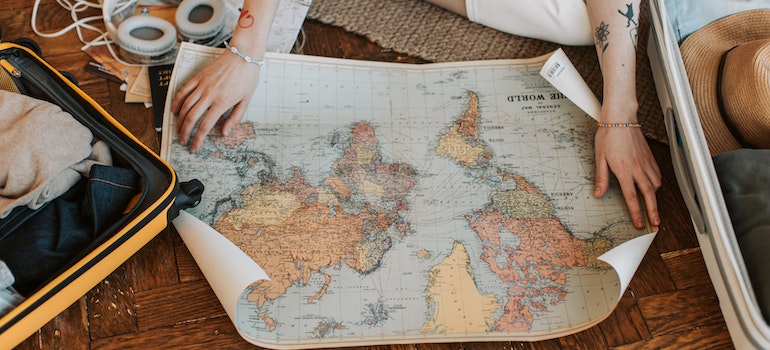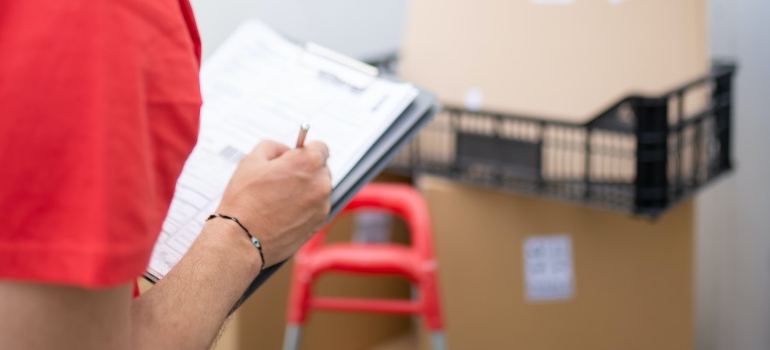A Guide to Shipping Personal Items Overseas
Relocating overseas has become more than just a fleeting thought for many Americans in today’s increasingly globalized world. Yet, moving across international borders is a significant undertaking, whether it’s for a career move, family reasons, or simply the lure of a new environment. And central to this process is shipping personal belongings, from furniture to household items. Ensuring these possessions reach their destination safely and efficiently is no small feat, which is why Hansen Bros. Moving & Storage and this guide aim to demystify the complexities of shipping personal items overseas, providing practical insights. As you prepare for this major life transition, arm yourself with the knowledge to make informed decisions and save time, money, and–peace of mind.
Deciding What to Ship and What to Leave Behind
Making the decision to relocate overseas is monumental, but equally challenging is discerning which personal belongings to take with you and which to part with. These choices aren’t merely about space but revolve around the practical, financial, and sentimental value of each item.
- Evaluating Possessions: As you sift through your belongings, it’s crucial to strike a balance. While some items have irreplaceable sentimental value, others can be weighed against their financial worth. Assess what truly matters and what can be substituted.
- Replacement vs. Shipping Costs: It might come as a surprise, but in certain cases, it’s financially wiser to purchase items in your new location rather than bear the shipping expenses. Items like bulky furniture or easily replaceable appliances might fall into this category.
- Electrical Compatibility: Before packing up your electronics, consider voltage and plug variations. Many countries have different electrical standards, and your devices might require adapters, or they might not be compatible altogether.
As you evaluate and decide, remember these considerations will play a significant role in determining the type and scale of your shipment. This naturally leads to our next pivotal decision: choosing the optimal shipping option for your bigger items.

Types of Shipping Options for Larger Items
Once you’ve decided what belongings will make the journey with you, it’s time to examine the shipping options available. Your choices largely depend on the size, value, and urgency of the items being transported. Here are the main types to consider, each option with its advantages and limitations, to help you decide.
Container Shipping
Container shipping remains a preferred choice for many when moving sizable household items. You have two primary choices:
- Personal containers: Dedicated solely to your items, ensuring they’re not mixed with others.
- Shared containers: A space-saving and cost-effective option where your belongings share space with other shipments.
Many in the Pacific Northwest, particularly through local international commercial shipping companies, have found both these options accessible and efficient.
Airfreight
When time is of the essence, airfreight steps in. It’s the fastest way to get your belongings to your new location, but it’s also typically more expensive. This method of shipping personal items overseas is most suitable for smaller, essential things that you’ll need immediately upon arrival.
Specialized International Movers
Managing the process of moving large items internationally requires expertise. Specialized international movers offer this, handling the nuances and challenges that come with overseas relocations. Those starting their journey in areas with extensive shipping networks, such as international movers Seattle offers, often benefit from a broader range of services and insights.
Considering your individual needs alongside these options will guide you toward the most effective shipping solution for your overseas move. As you finalize your shipping method, ensuring the safety of your belongings through proper packing becomes paramount.

Packing Household Items for Safety
The safety of your personal belongings during their overseas journey hinges significantly on how they’re packed. The right approach can mean the difference between your items arriving intact or damaged.
Professional Packing Services
Opting for professional services ensures that experts handle your valuables, employing industry best practices. They bring the advantage of experience, ensuring items are packed efficiently and securely. However, this comes at a cost, and for some, the expense might outweigh the benefits.
DIY Packing
If you decide to pack yourself, meticulous planning is key. For furniture, disassemble what you can and protect corners and surfaces. Appliances should be cleaned, dried, and securely boxed. Delicate items require special attention; use plenty of cushioning and ensure they’re not free to move within their boxes.
Materials
The materials you use play a pivotal role in safeguarding your belongings. Wooden crates, especially those like the shipping crates Seattle provides, provide a sturdy exterior, guarding against external pressures. Bubble wrap is essential for cushioning, furniture pads protect surfaces from scratches, and for items like artworks or electronics, it is advisable to use materials such as acid-free tissue paper and anti-static bubble wrap, respectively, to prevent damage.
As you prepare for shipping personal items overseas, it’s equally crucial to be well-informed about the destination’s customs regulations.

Understanding Customs, Duties, and Import Restrictions
Transitioning your household items across international borders involves more than just packing and shipping. You’ll need a solid grasp of the regulations and restrictions surrounding the import of personal belongings.
Household Goods Import
Before you move, consult the local embassy or consulate of your destination country. They can offer insights into the importation of household goods. Many countries grant concessions for used personal items, categorizing them as non-commercial imports. Accurate research upfront can minimize import duties or even secure exemptions.
Prohibited Items
Countries maintain specific lists of restricted imports, but shipping companies also have their own set of prohibitions. For instance, while a country may allow certain materials, your chosen shipper might have rules against them due to safety or storage concerns. Commonly prohibited items include hazardous materials, perishables, and certain high-value items.
Furthermore, specific items like untreated wood in furniture might face bans in particular countries due to pest control concerns. Always cross-check with both your shipping company and the destination’s customs department to avoid unexpected rejections or penalties.
Inventory Preparation
A detailed inventory aids in customs declarations and forms the basis for your insurance coverage. If unsure, seek assistance from professional valuation services, particularly for expensive or rare belongings. With these preparations, you can confidently address the customs process, setting a strong foundation for the upcoming task of ensuring your possessions during their transport.

Insuring Your Shipments
Ensuring the physical safety of your belongings during an international move is paramount, but financial protection through proper insurance is equally vital.
Why Insurance Matters when Shipping Personal Items Overseas
From potential mishandling and accidents to environmental factors like storms, the risks in international shipping are real. Insurance serves as a safety net, offering peace of mind that you’re protected against these unpredictable scenarios.
Types of Coverage
Not all insurance is created equal. It’s essential to know the difference between the two most important types. Full Replacement Value coverage will compensate you for the current market value of a lost or damaged item. In contrast, Released Value calculates the compensation based on the item’s weight, often leading to a much lower payout.
Valuing Your Items
Determine the worth of your possessions accurately. Underestimating can leave you underinsured while overestimating can lead to higher premiums. Professional appraisals or recent purchase receipts can help in setting the right insured value.
Natural Disasters
You should ensure your policy covers unforeseen events like sea storms, earthquakes, or other natural disasters. Especially when transporting via sea or areas prone to specific natural events, this coverage is indispensable.
Making a Claim
Should your items face damage or loss, act promptly. Notify your insurance company, provide required documentation like photos or purchase receipts, and follow their outlined process. Timely action increases the likelihood of a favorable resolution. Properly insuring your shipments not only protects your financial interests but also grants you added confidence during the intricate process of international relocation.
Securing the right insurance sets the tone for a smooth relocation. As you ensure your items’ safety, also consider the financial side of things, which leads to the crucial task of costs and budgeting for large-scale moves.

Budgeting for Shipping Personal Items Overseas
Preparing for an international move requires a keen understanding of the associated expenses to ensure there are no financial surprises along the way.
Container Costs
Container prices vary primarily based on size. A 20-foot container might be perfect for a smaller household, whereas a larger home could necessitate a 40-foot one. If you don’t have enough items to fill an entire container, consider a shared option, known as “Less Than Container Load” (LCL), which can be more cost-effective.
Additional Services
Various services can add to your moving budget. These include professional packing, door-to-door delivery, and even Seattle storage solutions if there’s a gap between moving out and settling in your new home. Evaluate the need and convenience of each service against its cost.
Hidden Fees
Be wary of fees that aren’t immediately obvious. These can encompass port charges, quarantine inspections, or even fees for specific documentation. A comprehensive discussion with your moving company can shed light on these potential costs. With a clear financial picture in place, you’re in a stronger position to manage the entire process efficiently, from the initial pick-up to the final delivery at your new destination.
Managing the Move: From Pick-up to Delivery
A successful international move hinges on meticulous planning and staying informed at every juncture.
Moving Timeline
Initiating your move should commence well in advance. Typically, a window of 2-3 months allows sufficient time to assess moving companies, get quotes, and finalize bookings. Last-minute rushes can lead to oversight and higher costs.
Tracking Your Shipment
With modern technology, keeping an eye on the whereabouts of your belongings has become simpler. Most reputable movers provide online tracking systems. Monitoring your shipment ensures you’re prepared for its arrival and can alleviate anxieties associated with long-distance moves.
Delivery Logistics
Smooth delivery is more than just a date on a calendar. It’s crucial to ensure the destination has proper access for delivery trucks, especially in areas with narrow roads or height restrictions. Additionally, discuss unloading services in advance, as some items might require specialized tools, heavy equipment movers, or additional manpower. In cases where your new home isn’t ready, explore temporary storage solutions with your mover.
A well-coordinated move ensures the safety and timely arrival of your items. But beyond the broader logistics, pay attention to the finer details, especially when you are dealing with fragile or valuable items.

Special Considerations for Fragile or Valuable Items
Relocating comes with its set of challenges, but when you’re transporting fragile or high-value items, the stakes are even higher.
- Antiques and heirlooms are timeless pieces that require specialized attention. Wooden antiques, for instance, can warp in fluctuating temperatures. Therefore, opt for climate-controlled shipping.
- Artworks, especially oil paintings, can be sensitive to temperature and humidity. Secure specialized shipping that provides temperature control.
- Musical instruments, like pianos or violins, not only need protective packaging but may also benefit from bespoke piano movers Seattle has and shipping services that understand their unique requirements.
While ensuring specialized care for your delicate and valuable belongings is crucial, it’s equally vital to be well-versed in international laws and regulations that dictate their shipment and entry.
Understanding International Laws and Regulations
Crossing international borders with personal belongings means you’re entering the web of global regulations. It’s not just about packing and shipping; it’s about ensuring your items are legally allowed entry into your new home country.
Quarantines
Certain countries, especially those with unique ecosystems like New Zealand and Australia, have strict quarantine laws. For instance, wooden items might need to be fumigated or treated to ensure they’re not harboring pests. Some countries even have specific regulations for items like soil-touched gardening tools or certain types of shoes that could potentially introduce foreign contaminants.
Regulations on Vehicles
Shipping vehicles internationally is more than just about transportation. Each country has its own emission standards, safety requirements, and even specifications like the side of the vehicle the driver’s seat should be on. For instance, importing older vehicles might be subject to additional duties in countries with strict emission standards. On the other hand, some nations offer tax breaks or exemptions for returning citizens or new immigrants bringing their personal vehicles.
Duty and Tax Regulations
It’s essential to be aware of potential duties or taxes on items you’re importing. While many countries allow returning citizens to bring back household goods without significant duties, there might be specific categories of items, like electronics or luxury goods, that could be taxable. Always check the duty-free allowance and understand the valuation methods employed by customs authorities in the destination country.
Being informed and proactive can save you from unforeseen challenges, penalties, or even confiscation of items at the border. Engage with professionals or consult embassy websites to get a clear picture of the rules that apply to your shipment.
Securing a Smooth International Move
Relocating internationally and shipping personal items overseas are ventures filled with decisions and meticulous details. From selecting the right items to ship and navigating complex shipping choices to grasping varied regulations and duties, every step counts. However, each challenge offers an opportunity to streamline and enhance your moving experience. With the right information and a well-planned shipping strategy, you can ensure a harmonious beginning in your new locale, confidently awaiting the arrival of your valued belongings.
Why Choose Us
History
Hansen Bros. Moving & Storage is locally owned and operated by the same family for four generations, since 1890. We have a well-established reputation for service quality and reliability with a high percentage of repeat household and commercial clients.
Professionalism
We’re a certified ProMover by the American Moving and Storage Association with A+ rating with the Better Business Bureau, voted “Best in Western Washington” in 2009 and from 2011 to 2016 by KING5. Our company is fully licensed and insured and member of WMC and AMSA.
Value
Hansen Bros. Moving & Storage provide free, no-obligation in-home estimate and competitive rates, including low minimum rates for shipments moving under 300 miles. We’ve set a refund policy for unused packing materials and three Puget Sound locations to help clients save on travel fee costs.



